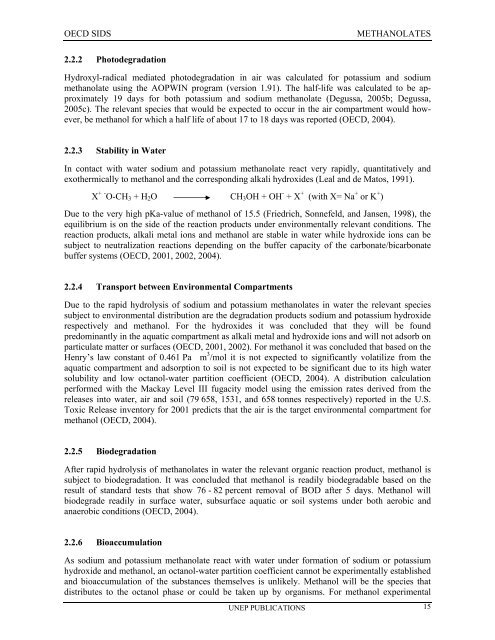Sodium methanolate - ipcs inchem
Sodium methanolate - ipcs inchem
Sodium methanolate - ipcs inchem
You also want an ePaper? Increase the reach of your titles
YUMPU automatically turns print PDFs into web optimized ePapers that Google loves.
OECD SIDS<br />
METHANOLATES<br />
2.2.2 Photodegradation<br />
Hydroxyl-radical mediated photodegradation in air was calculated for potassium and sodium<br />
<strong>methanolate</strong> using the AOPWIN program (version 1.91). The half-life was calculated to be approximately<br />
19 days for both potassium and sodium <strong>methanolate</strong> (Degussa, 2005b; Degussa,<br />
2005c). The relevant species that would be expected to occur in the air compartment would however,<br />
be methanol for which a half life of about 17 to 18 days was reported (OECD, 2004).<br />
2.2.3 Stability in Water<br />
In contact with water sodium and potassium <strong>methanolate</strong> react very rapidly, quantitatively and<br />
exothermically to methanol and the corresponding alkali hydroxides (Leal and de Matos, 1991).<br />
X + - O-CH 3 + H 2 O CH 3 OH + OH - + X + (with X= Na + or K + )<br />
Due to the very high pKa-value of methanol of 15.5 (Friedrich, Sonnefeld, and Jansen, 1998), the<br />
equilibrium is on the side of the reaction products under environmentally relevant conditions. The<br />
reaction products, alkali metal ions and methanol are stable in water while hydroxide ions can be<br />
subject to neutralization reactions depending on the buffer capacity of the carbonate/bicarbonate<br />
buffer systems (OECD, 2001, 2002, 2004).<br />
2.2.4 Transport between Environmental Compartments<br />
Due to the rapid hydrolysis of sodium and potassium <strong>methanolate</strong>s in water the relevant species<br />
subject to environmental distribution are the degradation products sodium and potassium hydroxide<br />
respectively and methanol. For the hydroxides it was concluded that they will be found<br />
predominantly in the aquatic compartment as alkali metal and hydroxide ions and will not adsorb on<br />
particulate matter or surfaces (OECD, 2001, 2002). For methanol it was concluded that based on the<br />
Henry’s law constant of 0.461 Pa m 3 /mol it is not expected to significantly volatilize from the<br />
aquatic compartment and adsorption to soil is not expected to be significant due to its high water<br />
solubility and low octanol-water partition coefficient (OECD, 2004). A distribution calculation<br />
performed with the Mackay Level III fugacity model using the emission rates derived from the<br />
releases into water, air and soil (79 658, 1531, and 658 tonnes respectively) reported in the U.S.<br />
Toxic Release inventory for 2001 predicts that the air is the target environmental compartment for<br />
methanol (OECD, 2004).<br />
2.2.5 Biodegradation<br />
After rapid hydrolysis of <strong>methanolate</strong>s in water the relevant organic reaction product, methanol is<br />
subject to biodegradation. It was concluded that methanol is readily biodegradable based on the<br />
result of standard tests that show 76 - 82 percent removal of BOD after 5 days. Methanol will<br />
biodegrade readily in surface water, subsurface aquatic or soil systems under both aerobic and<br />
anaerobic conditions (OECD, 2004).<br />
2.2.6 Bioaccumulation<br />
As sodium and potassium <strong>methanolate</strong> react with water under formation of sodium or potassium<br />
hydroxide and methanol, an octanol-water partition coefficient cannot be experimentally established<br />
and bioaccumulation of the substances themselves is unlikely. Methanol will be the species that<br />
distributes to the octanol phase or could be taken up by organisms. For methanol experimental<br />
UNEP PUBLICATIONS 15
















